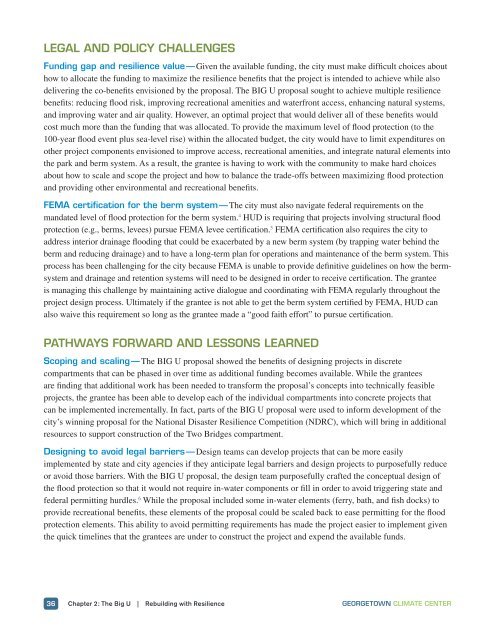Rebuilding with Resilience
dw0r306aHfX
dw0r306aHfX
You also want an ePaper? Increase the reach of your titles
YUMPU automatically turns print PDFs into web optimized ePapers that Google loves.
LEGAL AND POLICY CHALLENGES<br />
Funding gap and resilience value — Given the available funding, the city must make difficult choices about<br />
how to allocate the funding to maximize the resilience benefits that the project is intended to achieve while also<br />
delivering the co-benefits envisioned by the proposal. The BIG U proposal sought to achieve multiple resilience<br />
benefits: reducing flood risk, improving recreational amenities and waterfront access, enhancing natural systems,<br />
and improving water and air quality. However, an optimal project that would deliver all of these benefits would<br />
cost much more than the funding that was allocated. To provide the maximum level of flood protection (to the<br />
100-year flood event plus sea-level rise) <strong>with</strong>in the allocated budget, the city would have to limit expenditures on<br />
other project components envisioned to improve access, recreational amenities, and integrate natural elements into<br />
the park and berm system. As a result, the grantee is having to work <strong>with</strong> the community to make hard choices<br />
about how to scale and scope the project and how to balance the trade-offs between maximizing flood protection<br />
and providing other environmental and recreational benefits.<br />
FEMA certification for the berm system — The city must also navigate federal requirements on the<br />
mandated level of flood protection for the berm system. 4 HUD is requiring that projects involving structural flood<br />
protection (e.g., berms, levees) pursue FEMA levee certification. 5 FEMA certification also requires the city to<br />
address interior drainage flooding that could be exacerbated by a new berm system (by trapping water behind the<br />
berm and reducing drainage) and to have a long-term plan for operations and maintenance of the berm system. This<br />
process has been challenging for the city because FEMA is unable to provide definitive guidelines on how the bermsystem<br />
and drainage and retention systems will need to be designed in order to receive certification. The grantee<br />
is managing this challenge by maintaining active dialogue and coordinating <strong>with</strong> FEMA regularly throughout the<br />
project design process. Ultimately if the grantee is not able to get the berm system certified by FEMA, HUD can<br />
also waive this requirement so long as the grantee made a “good faith effort” to pursue certification.<br />
PATHWAYS FORWARD AND LESSONS LEARNED<br />
Scoping and scaling — The BIG U proposal showed the benefits of designing projects in discrete<br />
compartments that can be phased in over time as additional funding becomes available. While the grantees<br />
are finding that additional work has been needed to transform the proposal’s concepts into technically feasible<br />
projects, the grantee has been able to develop each of the individual compartments into concrete projects that<br />
can be implemented incrementally. In fact, parts of the BIG U proposal were used to inform development of the<br />
city’s winning proposal for the National Disaster <strong>Resilience</strong> Competition (NDRC), which will bring in additional<br />
resources to support construction of the Two Bridges compartment.<br />
Designing to avoid legal barriers — Design teams can develop projects that can be more easily<br />
implemented by state and city agencies if they anticipate legal barriers and design projects to purposefully reduce<br />
or avoid those barriers. With the BIG U proposal, the design team purposefully crafted the conceptual design of<br />
the flood protection so that it would not require in-water components or fill in order to avoid triggering state and<br />
federal permitting hurdles. 6 While the proposal included some in-water elements (ferry, bath, and fish docks) to<br />
provide recreational benefits, these elements of the proposal could be scaled back to ease permitting for the flood<br />
protection elements. This ability to avoid permitting requirements has made the project easier to implement given<br />
the quick timelines that the grantees are under to construct the project and expend the available funds.<br />
36 Chapter 2: The Big U | <strong>Rebuilding</strong> <strong>with</strong> <strong>Resilience</strong> GEORGETOWN CLIMATE CENTER


